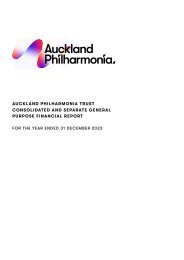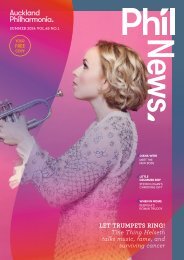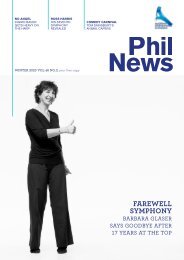APO Annual Report 2020
You also want an ePaper? Increase the reach of your titles
YUMPU automatically turns print PDFs into web optimized ePapers that Google loves.
<strong>APO</strong> ANNUAL REPORT <strong>2020</strong><br />
AUCKLAND PHILHARMONIA TRUST<br />
CONSOLIDATED AND SEPARATE FINANCIAL STATEMENTS<br />
FOR THE YEAR ENDED 31 DECEMBER <strong>2020</strong><br />
Notes to the consolidated and separate financial statements<br />
4. SIGNIFICANT ACCOUNTING POLICIES (CONT'D)<br />
Financial liabilities at amortised cost<br />
After initial recognition, trade and other payables are subsequently measured at amortised cost using the effective<br />
interest rate method.<br />
Trade and other payables are unsecured and are usually paid within 30 days of recognition. Due to their short-term<br />
nature they are not discounted.<br />
d) Impairment of financial assets<br />
The Group assesses, at each reporting date, whether there is objective evidence that a financial asset or a group of<br />
financial assets is impaired. An impairment exists if one or more events that has occurred since the initial recognition<br />
of the asset (an incurred ‘loss event’) has an impact on the estimated future cash flows of the financial asset or the<br />
group of financial assets that can be reliably estimated.<br />
The Group considers evidence of impairment for financial assets measured at amortised cost (loans and receivables)<br />
at both a specific asset and collective level.<br />
An impairment loss in respect of a financial asset measured at amortised cost is calculated as the difference between<br />
its carrying amount and the present value of the estimated future cash flows discounted at the asset’s original<br />
effective interest rate. Losses are recognised in surplus or deficit and reflected in an allowance account against loans<br />
and receivables. Interest on the impaired asset continues to be recognised.<br />
When an event occurring after the impairment was recognised causes the amount of impairment loss to decrease,<br />
the decrease in impairment loss is reversed through surplus or deficit.<br />
e) Property, plant and equipment<br />
i. Initial recognition and subsequent expenditure<br />
Property, plant and equipment is measured initially at cost. Cost includes expenditure that is directly attributable to<br />
the acquisition of the items. The cost of an item of property plant and equipment is recognised only when it is<br />
probable that future economic benefit or service potential associated with the item will flow to the Group, and if<br />
the item’s cost or fair value can be measured reliably.<br />
Subsequent costs that meet the recognition criteria above are recognised in the carrying value of the item of<br />
property, plant and equipment. Such cost includes the cost of replacing part of the property, plant and equipment<br />
if the recognition criteria are met. When significant parts of property, plant and equipment are required to be<br />
replaced at intervals, the Group recognises such parts as individual assets with specific useful lives and depreciates<br />
them accordingly.<br />
ii. Subsequent measurement<br />
Subsequent to initial recognition, property, plant and equipment are measured at cost, net of accumulated<br />
depreciation and impairment losses, if any.<br />
iii. Depreciation<br />
Depreciation is charged on a straight-line basis unless specified otherwise below.<br />
Depreciation is charged at rates calculated to allocate the cost or valuation of the asset less any estimated residual<br />
value over its remaining useful life:<br />
Land<br />
not depreciated<br />
Buildings and improvements<br />
4-10% diminishing balance method<br />
Office equipment<br />
2-20 years<br />
Computer equipment<br />
3-5 years<br />
Musical instruments<br />
3-25 years<br />
Music stands<br />
5-10 years<br />
Music<br />
25 years<br />
Motor vehicles<br />
3-6 years<br />
Office refurbishment<br />
5 years<br />
42<br />
15
















